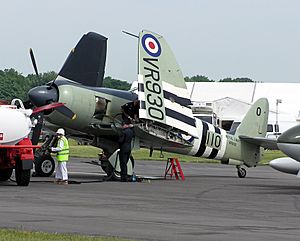Royal Navy Historic Flight facts for kids
Quick facts for kids Royal Navy Historic Flight |
|
|---|---|

Hawker Sea Fury FB.11 VR930 with wings folded, at Kemble Airfield, Gloucestershire, England
|
|
| Active | 1972 – 31 Mar 2019 |
| Allegiance | |
| Branch | |
| Type | Naval Historic Flight |
| Part of | Fleet Air Arm |
| Garrison/HQ | RNAS Yeovilton (HMS Heron) |
| Equipment | Fairey Swordfish Fairey Firefly Sea Fury Sea Hawk |
| Commanders | |
| Current commander |
Lieutenant-Commander Chris Götke AFC |
| Commodore-in-Chief | Prince Andrew, Duke of York |
The Royal Navy Historic Flight (RNHF) was a special group that kept old airplanes from the Royal Navy's Fleet Air Arm flying. It was like a flying museum! These planes were important to British naval aviation history. The RNHF was based at RNAS Yeovilton and often showed off its aircraft at air displays. It was not part of the military but a charity, run by civilian staff.
The RNHF stopped operating in March 2019. After that, its amazing aircraft, like the Swordfish Mk.I, Sea Fury FB.11, Sea Hawk FGA.6, and Chipmunk T.10, were given to the Fly Navy Heritage Trust. This trust now helps fund the displays of these historic planes through charity events.
History of the Flight
The Royal Navy Historic Flight started at RNAS Yeovilton in 1972. It became home to several aircraft that had been given to the Royal Navy over many years. The very first plane was a Fairey Swordfish II, given by Westland Aircraft in 1960.
Later, in 1971, Hawker Siddeley gave a Hawker Sea Fury FB.11. In 1972, a Fairey Firefly AS.5 was donated. The separate groups that looked after these three planes joined together in 1972. This is how the Historic Flight was officially formed.
Over the years, the RNHF received more aircraft as gifts. These came from the German government, the Royal Navy, and British Aerospace. Experts also helped to rebuild and fix up the planes. Sadly, three aircraft were lost in accidents, and two people died.
In 1995, the ground staff who worked on the planes became civilian employees instead of navy personnel. However, the pilots were still serving navy pilots who volunteered their free time. They used the Flight's DHC Chipmunk plane for training. The Fly Navy Heritage Trust (also known as Navy Wings) is a charity that helped raise money for the RNHF's staff. The Flight also earned money from air shows, donations from the public, and support from aerospace companies.
The Royal Navy once explained the important job of the historic flight. They said the RNHF was a charity that wanted to make sure these unique British planes kept flying. Their goal was to help future generations understand the people who built, maintained, flew, and fought in naval aircraft from the past. They wanted people to experience the real sound, smell, and sight of these planes in the air. The RNHF delighted millions of people with their air displays and taught future generations.
Historic Aircraft Collection
The Royal Navy Historic Flight looked after several amazing aircraft. Here are some of the types of planes they had:
| Aircraft type | Serial | Notes |
| Fairey Swordfish Mk.I | W5856 | This plane was used for training during the war. It was restored and flew again in 1993. A big rebuild finished in 2015, making it ready to fly. |
| Fairey Swordfish Mk.II | LS326 | This plane served on special ships during the war. It even appeared in the movie Sink the Bismarck!. It was taken out of service in 2002 due to rust. New parts were made, and it was flying again by 2010. |
| Fairey Swordfish Mk.III | NF389 | This aircraft was being rebuilt as of 2009. |
| Fairey Firefly AS.5 | WB271 | This plane was destroyed during an air display in July 2003. Sadly, both pilots were killed. |
| Hawker Sea Fury FB.11 | TF956 | This plane was lost in 1989 due to a problem with its hydraulic system. The pilot survived. |
| Hawker Sea Fury T.20 | WG655 | This plane was badly damaged in 1990 after its engine failed. The pilot survived. It was later sold and rebuilt to fly again. It was damaged again in 2020 after another engine problem. |
| Hawker Sea Fury T.20 | VX281 | This plane was damaged during an emergency landing in 2014. The pilot, Lt Cdr Chris Götke, received an award for his actions. It was seriously damaged again in 2021 after engine trouble. |
| Hawker Sea Fury FB.11 | VR930 | This plane is currently not in use. |
| Hawker/Armstrong Whitworth Sea Hawk FGA.6 | WV908 | This plane is currently in storage. |
| de Havilland DHC-1 Chipmunk T.10 | WK608 | This plane was used for pilot training and is still able to fly. |
Images for kids
See also
- Battle of Britain Memorial Flight – a similar group that flies historic planes for the Royal Air Force.








